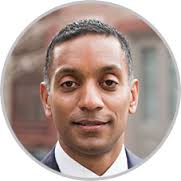MarketsMuse.com merges Fixed Income and FinTech with continuing coverage of the corporate bond market’s effort to evolutionize via electronification with a focus on yet the latest innovator initiative courtesy of Goldman Sachs alumni Amar Kuchinad and his start-up“Electronofie.” Our hats are off in salute to the catchy company name and extracts below are courtesy of recent profile in Fortune Magazine. Roger Daltry adds: “Dealers, Can You Hear Me?” Or, As Victor Hugo once wrote, “nothing is stronger than an idea whose time has come.”
Fortune Mag’s Shawn Tulley “takes it away” starting here:
It sure looks like the Golden Age for bonds. The $7.7 trillion U.S. corporate fixed income market is the largest source of liquidity on the planet for companies, and individual investors, pension funds, and endowments are flocking to bonds as never before.
So it’s hard to believe that anything this important could be so trapped in the past. At America’s biggest, most-tech savvy asset managers, traders speed-dial their favorite Wall Street salesman to place their biggest orders over their trademark headphones, just as in the Liar’s Poker era. The electronic platforms that transformed the equity markets decades ago mainly never arrived for the bond market. Relative to stocks, big-ticket fixed-income trading is stuck in the Stone Age.
Naturally, the beneficiaries are the investment banks who charge fat markups and, frequently, their hedge fund clients, who feast off of the constant leaks on who’s buying and selling big chunks of bonds, information that Wall Street firms use to cement their most lucrative relationships.

Now, a Wall Street renegade is poised to revolutionize the market for those mega-trades and, in the process, potentially lower trading costs by 80%. Amar Kuchinad, 40, worked as a fixed-income trader at Goldman Sachs from 2005 to 2011, then spent more than a year as a senior advisor at the SEC, studying regulatory measures for streamlining bond transactions. Kuchinad is a brainiac applied math major from Harvard and a student of game theory. He has a passion for designing systems that even the shrewdest traders cannot “game,” environments that keep such traders from figuring out who’s buying and selling, then using that knowledge to move prices against them, a practice that swells trading costs.
“Wall Street is interested in maintaining the status quo and their margins in the voice market,” says Kuchinad. “Those with the expertise to set up new systems were well compensated not to set them up.”
Now that tight regulations have curbed Wall Street’s role in fixed income trading, rebels such as Kuchinad are using the view from inside the machine, the experience gleaned on trading floors, to uproot the most outdated, entrenched bastion in financial services.
In March 2014, Kuchinad founded Electronifie, a venture backed by $12 million raised from family and friends. Based in lower Manhattan, Electronifie has designed a potentially groundbreaking electronic bond trading platform that’s ready for action. By the end of April, it will be fully operational, directly matching buy and sell orders from the world’s biggest owners of bonds, asset managers, foundations, sovereign wealth and hedge funds. It’s impossible to know whether a system this disruptive will succeed. But the timing is right. And if Electronifie does flourish, it’s likely that big-ticket fixed income trading will, finally and belatedly, join equities in the electronic age.
Of course, electronic bond trading is nothing new. The leading pioneer is MarketAxess, a highly successful exchange that now executes around 15% of all investment-grade transactions. MarketAxess specializes in orders up to around $5 million. It primarily matches bids and asks placed by “dealers,” meaning banks and brokers, and has enormously lowered costs for executing these smaller and medium-sized trades.
Electronifie is aiming at a different market: extra-large transactions of $5 million to $50 million, or even more. Those trades account for around 50% of all investment -grade transactions, measured in dollars. “We’re solving a different problem,” says Kuchinad. “Portfolio managers change their strategies, and have to buy or sell tens of millions of dollars in a single bond. Or they experience big outflows from investors, and have to sell large blocks of bonds.”
Electronifie wants to fundamentally change the way those big blocks of bonds change hands. Today, the vast bulk of transactions go through intermediaries, banks or brokers that take an order from the party that actually owns the bonds, such as a BlackRock or Fidelity, and matches the order with another party with a big fixed income portfolio.
The “end-users” seldom trade directly with one another. Electronifie connects the asset managers, pension funds, and the like so that they buy and sell from each other without an investment bank serving as a go-between. Electronifie is focusing on the market where “voice” is most prevalent, those giant trades. “We expect close to 100% of our trades to be between the principals,” says Kuchinad. “And we eventually expect the average size to be around $20 million.” If Kuchinad succeeds, it will be a phenomenon fixed income trading has never witnessed. Electronifie is also likely to draw competing platforms that, in turn, will accelerate the shift in which, say, CalPERS —California’s massive public employee pension system—can sell blocks of bonds directly to Fidelity, with neither side having the slightest clue of who’s taking their order.
For the full story from Fortune Mag, (its a great read for those following the electronification of corporate bond markets), please click here.

